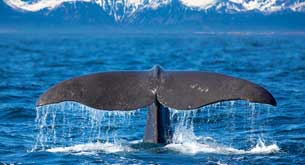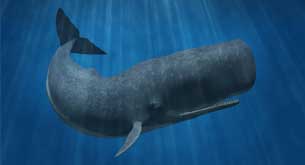Facts about Whales
Posted by Admin / in Science Facts
Whales are the largest animals on Earth. In fact, blue whales are the largest animals to ever live on Earth, even larger than the dinosaurs. Most types of whale also live a long time. There are many whales that live over 100 years.

A large whale surfacing to take a breath

The large flukes on a whale's tale helps them swim with power through the water
Baleen Whales
Baleen Whales include the largest whales. Blue whales, right whales, humpback whales and gray whales are fed using their baleens. Many baleen whales use their baleens to eat large quantities of krill (small shrimp-like creatures), plankton or zooplankton by filtering out gallons and gallons of water. Baleen whales are known as gentle giants to us. These huge creatures can be somewhat curious of people, but rarely disturb anyone, unless they are attacked.
Blue Whales - Blue whales are the largest of any type of whale. They can grow over 100 feet long (30 meters) and weigh over 200 tons. A Boeing 747 intercontinental jet weighs only 88 tons so a fully grown blue whale weighs more than two 747's. A full size elephant weighs less than 8 tons.
Right Whales - Right whales, particularly Northern Right whales are nearly extinct after hundreds of years of whale hunting occurred. Scientists estimate there are only 350 Northern Right Whales left.
Sei Whales - Sei whales are a smaller whale that feeds on krill and small fish. Sei whales are typically found in warmer water.
Bryde's Whales - Bryde's whales are another small whale that is very similar to the Sei whale. They live in warmer waters not too far from the equator.
Gray Whales - Gray whale are like other baleen whales, but they find food a little differently. Gray whale use the front of their head to stir up isopods and other tiny sea creatures from the bottom of the ocean. During the main summer feeding months, gray whales eat over 1 ton of food each day to gain strength and store blubber for the rest of the year.
Humpback Whales - Humpback whales are well known for their underwater noises that sound like whale songs and their ability to swim up out of the water.
Minke Whales The Minke whale is the smallest of the baleen whales, growing only as large as 30 feet (10 meters). They feed on krill and small fish.
Toothed Whales
Sperm whales, beluga whales and Orca Whales (Killer Whales) are some examples of toothed whales. This type of whale typically eats fish and other animals living in or near the oceans. They must catch their food so these types of whales are not as large as baleen whales.

Sperm Whale
Sperm Whales are among the largest of the toothed whales. Sperm whales have some distinct features that make them a little different than other whales. Sperm whale were named after the fluid inside their body. This fluid is unique because it turns to a wax-like material when it is cooled. Scientists do not know exactly why they have this fluid, but it may be used to help sperm whale dive to deeper parts of the ocean to get their food. Sperm whales can dive deeper than any other whale, over 3000 feet (1000 meters)! The fluid may help them to dive deeper and return to the surface since it changes states when it is cooled (liquid to solid). The fluid may also help protect them from the extreme pressure of the deeper water. Sperm whale dive deep to get their food. Their favorite food is giant squid which lives in deeper ocean waters.

Orca Whale performing for an audience
Fin Whales - Fin whales are another of the giant whales. They grow to a size of almost 70 feet long (22 meters). Fin whales eat fish, crustaceans and squid.
Orca Whales (Killer Whales) - Orcas are the largest carnivores on Earth. They are excellent hunters who eat fish, seals, sea turtles, sea lions and other small marine mammals, and squid. A pack (pod) of Orca whales will even attack and eat giant whales, such as the blue whale. Orca whales are fast swimmers who can propel their huge bodies out of the water. Orcas are featured in marine exhibits, such as Sea World's Shamu and movies, such as the Free Willy films.
False Killer Whales - False Filler Whales are about the same size as Orca whales, but they do not have the distinctive black and white coloring. False killer whales are also not as aggressive hunters as Killer whales, but they are known to eat fish and dolphins.
Beluga Whales - Beluga whales are a favorite at aquariums because of their small size and white coloring. Belugas live near the polar ocean regions. They prefer to use the ice as shelter and to find food. When the ice freezes near land in the winter, they move towards the open oceans, but as the ice melts they move back towards the land. They like to eat fish, shrimp, crabs, worms and other small creatures. Belugas find food on the sides and bottom of the ice or the bottom of the ocean. They can dive over a half mile deep (2500'+). Beluga whales are very vocal. Aquarium shows that feature belugas typically show off their vocals by allowing them make sounds for the audience.
Pilot Whales - Pilot whales are smaller whales that grow to a size of 12-20 feet long. They are featured by aquariums because they adapt well to captivity. They eat mostly squid and fish. Pilot whales are known to dive deep in the ocean (over 1500 feet) to capture squid and other animals that live near the bottom.
FACTS ABOUT WHALES
-
Whales are mammals, not fish.
-
Whales breathe air from the surface. They cannot breathe underwater.
-
Whales breathe through a blowhole on top their head, not through their mouth.
-
Some whales have one blowhole, others have two.
-
Whales hearts only beat 20 times per minute, but each heart beat pumps over 70 gallons of blood.
-
Many whales migrate, similar to birds, moving from one climate to another.
-
Whales are very similar to dolphins and porpoises, only they are much larger.
-
There are two categories of whales including toothed whales and baleen whales.
-
Baleen whales filter their food. They swallow large amounts of sea water and filter out the food through their baleen plates.
-
Baleens are made of keratin like human fingernails. The baleen plates will re-grow throughout a whale's life.
-
Whale bones are more porous than land mammals. An oil surrounds the bones (oil is lighter than water), helping the whale stabilize and float in the water.
-
Unlike fish, whale tales are flat. The shape of their tale is like an airplane wing, thicker at the front than the back.
-
Whales have thick blubber under their skin which keeps them warm in very cold water.
-
All whales have hair. They are mammals!
Protecting Whales
Whale watching has enjoyed popularity for many years. From the whale hunting time period to today where people visit the ocean in hopes of seeing the largest animals on Earth, people have had a desire to find whales. Today people are using new technology to find whales for a different reason, to protect the whales. Large ships can cause harm to whales when they strike the whales. In the past, one of the only ways to miss whales was by visually spotting the whales. Today scientists have developed new technology to find whales in a effort to protect them from large ships. Since whales make vocal sounds when they swim, scientists use floating buoys in their shipping lanes, equipped with sound detection technology. The equipment compares the sound to sound waves produced by whales. When there is a possible match, a whale expert will listen to the sounds to verify if there is a whale in the area. When whales are located, alerts are sent out to the ship captains. In some cases, ships slow down to give the whales more time to move out of the way.
Another way scientists are using new ways to detect whales is by using infrared technology. When whales swim, they stir up colder water from lower depths of the ocean. Large ships also do this, but there is a difference. The pattern for whales is not continuous, like a ship since they constantly change their depth as they dive and return to the surface for air. Infrared technology can locate and track whales by looking for this type of pattern.
